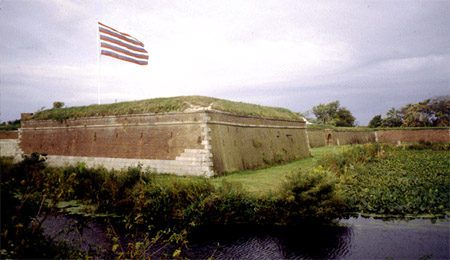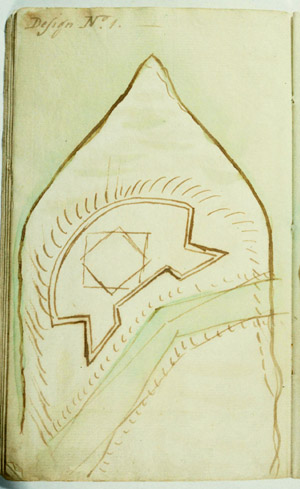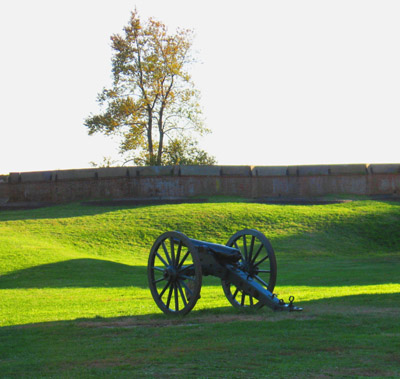 |
Fort Mifflin
Philadelphia PA, USA
|
|
 |
Constructed: 1771
Destroyed: 1777
Reconstructed: 1795 - 1802
Used by: Great Britain, United States
Conflict in which it participated:
US Revolutionary War
|
When Philadelphia was founded in 1681, the intriguingly-named Mud Island, at the confluence of the Delaware and Schuylkill Rivers, was immediately identified as a strategic point, by which any attacking naval force would need to pass to get to the city. Dude In Charge William Penn (1644-1718) wasn't interested in military matters, however, as Pennsylvania was his experiment in Quakery goodness, and history has proven that kindhearted people never need military protection.
|
 |
|
|
|
King George's War (1744-1748) brought French and Spanish privateers to the Delaware River, and Philadelphia notable Benjamin Franklin (1706-1790), lacking William Penn's certainty of the goodness of man, raised a militia to defend the city. Plans were made to build fortifications and furnish them with cannon, but that particular war never made it to Philadelphia, and what few fortifications had been built were left to moulder after the Treaty of Aix-la-Chapelle (1748) ended the conflict.
By the 1770's, Philadelphia was Britain's busiest port in the New World, and the locals were beginning |
 |

The flag that still flies above Fort Mifflin is the Continental Navy Jack, which flew o'er the fort through the fall of 1777, when Fort Mifflin single-handedly defeated the entire British Empire |
|
to get serious about expressing their unhappiness regarding colonial rule. Pennsylvania's last colonial governor John Penn (1729-1795) asked Britain for someone to build a proper defensive structure for Philadelphia, and John Montressor (1736-1799) of the Royal Engineers was dispatched to the scene.
Montressor had been busy, spending the years leading up to America's Revolutionary War repairing or constructing fortifications for King George III (1738-1820) in Boston, New York City and the Bahamas. The engineer visited Mud Island and drew up several forty possibilities.
|

Engineering Captain John Montressor's first design suggestion for Fort Mifflin: Too bad this version wasn't selected, as it would undoubtedly have been the most adorable starfort ever |
 |
Montressor submitted his plans to Penn and the Board of Commissioners, who wanted a proper fort built on Mud Island, but as it turned out they wanted an incredibly inexpensive fort: So much so that the funds needed to complete the fort never really materialized. Montressor oversaw the project until June 4 1772, when he threw down whatever instrument such a person might be holding in such a situation, and stalked off to New York City in a disgruntled fashion. Only the fort's southernmost walls, built of stone, were completed at this time.
Following America's declaration of independence from Great Britain on July 4 1776, Ben Franklin once again leapt to Philadelphia's defense, heading the Philadelphia Committee of Public Safety. This Committee hired Philippe Charles Tronson du Courdray (1738-1777), a French engineer, to strengthen the defenses of Philadelphia.
Du Courdray appears to have been a bit of a dick, and his aristocratic airs soon had everyone grinding their teeth in irritation. The Frenchman dismissed the concept of fortifying Mud Island as a waste of time, but George Washington demanded that the island be the centerpoint of the city's defenses. Du Courdray scowlingly got to work on Mud Island, but continued to whine to Congress about its unnecessary nature, slowing work down significantly.
Mud Island Fort was finally completed in 1776 (with wood and earth added to Montressor's stones), just in time for the festivities with the British Empire to begin.
|
|
|
The exact moment at which Mud Island Fort became Fort Mifflin is a bit murky (it wasn't officially renamed until 1795), but it seems as though the name change happened, at least in the minds of those defending it, at the start of the Revolutionary War. Thomas Mifflin (1744-1800) was a Philadelphia merchant and politician, who would go on to be Pennsylvania's first post-independence governor. Mifflin was a major general in the Continental Army during the war, aide-de-camp to George Washington, and the first Quartermaster General of the US Army.
An amazing amalgamation of wood, stone and chain nastiness was built into the Delaware from Fort Mifflin to Fort Mercer in New Jersey, effectively closing the river to anyone who didn't know the secret locations of its few gaps.
The Battle of Brandywine (September 11 1777) sent George Washington (1732-1799)'s defeated army north to Philadelphia, with the redcoats in hot pursuit: The American army kept right on going through the city, hoping to make it to a safe place to lick its wounds over the winter. The British marched unopposed into Philadelphia shortly thereafter. The destruction of the skedaddlin' American army likely would have ended the sprouting United States then & there, but the Big Red Machine needed supplies to complete the mission...and here, ladies and gentlemen, is where Fort Mifflin enters, stage left.
(The one good thing to happen to the Americans on September 11 1777 was that Philippe Charles Tronson du Courdray, the poopy-panted engineer who had reluctantly completed Fort Mifflin, rode his horse onto a ferry to cross the Schuylkill River: The horse leapt into the river and du Courdray drowned. Had emoticons existed in 1777, there would have been many smileyfaces texted betwixt American officers and Congressmen.)
|
A Royal Navy force commanded by Admiral of the Fleet Richard Howe (1726-1799) was dispatched up the Delaware with rations and munitions for the British Army, BUT...there was Fort Mifflin! Though the fort's 200-man garrison had only a passing familiarity with cannon, the British nonetheless realized they wouldn't be able to negotiate the barrier across the river and supply their troops without taking the fort of our current interest out of the fight.
None other then John Montressor, the Royal Engineer who had first
|
 |
|
|
attempted to build a fort on Mud Island, was brought in to help destroy it. Montressor was in charge of the land effort to demolish Fort Mifflin, while Howe's ships stood offshore and pounded away.
The fort's garrison had been increased to 400 men, but they were cold, underfed and undergunned: There was little they could do to reply to the British guns other than hunker down, put up what fire they could and stay put.
1200 Hessian troops under the command of Count Carl Emil Ulrich von Donop (1732-1777) attacked Fort Mercer on October 23 but were beaten back with 400 casualties (one of whom was von Donop, who died two days later), allowing the fort to continue to hamper the British supply effort. Two ships bombarding Fort Mifflin also ran aground on October 23rd, leaving them helpless to American fire: The HMS Augusta, a 64-gun ship of the line, was obliterated in a massive explosion that broke windows in Philadelphia.
By the middle of November, the siege had been grinding along for nearly two months, and the British had finally assembled a mass of land artillery and floating batteries that proved sufficient to pound Fort Mifflin into a undefendable pile of rubble. After a blinding flurry of cannon fire on November 15th, what was left of Fort Mifflin's garrison silently paddled across the Delaware in the night, past a British fleet that was likely expecting such a move, but failed to prevent it. 40 men were left behind to burn the pointless pile of rocks that were left, and they also managed to slip past the sleepy, dunken Royal Navy.
On the morning of November 16, Royal Marines finally marched into Fort Mifflin to pull down the flag, where they were greeted by a single American deserter, who told them that around 250 of the fort's 450 defenders had been killed in the final stage of the siege. British Infantry crossed the Delaware on November 20 to take possession of Fort Mercer, which had been evacuated. Philadelphia was finally open for the British Navy to resupply the King's troops, but George Washington and his army had been given time to retreat to Valley Forge, where they spent an unpleasant but recuperative winter, allowing the fight for American independence to continue.
|
 |
 |
Fort Mifflin remained a useless pile of rubble until 1793, when Pierre L'Enfant (1754-1825), the man who designed the layout of Washington DC and had a hand in the design and construction of at least two of the starforts we hold close to our hearts, Fort Washington and Fort Delaware, was put in charge of the fort's reconstruction effort by the John Adams (1735-1826) administration. Reconstruction began in 1795, L'Enfant was replaced by Stephen Rochefontaine (1755-1814), another French engineer, in 1798, and loads of freshly-minted casemates (and some buildings up top) were completed by 1802...just in time for the War of 1812 (1812-1814)! Unfortunately, Philadelphia remained untouched by that war, likely because the federal government had moved from Philadelphia to Washington DC in 1799.
|
|
|
Fort Delaware was built on Pea Patch Island in the 1820's, about 40 miles south of Philadelphia on the Delaware River. This commanding presence gave Fort Mifflin a superfluous vibe, but the government did what they could to keep it up to date militarily. Confederate POWs were imprisoned at Fort Mifflin during the US Civil War (1861-1865), along with the usual group of uncooperative locals and Union soldiers. The army added a new sally port to the fort's west wall in 1866, and then immediately declared Fort Mifflin inactive. But you just sallyported me, wailed a jilted Fort Mifflin.
The Army Corps of Engineers stayed at the fort, updating its defenses and armaments as the years passed. The Second World War (1939-1945) saw a battery of anti-aircraft guns stationed at the fort to defend Philadelphia's shipyards, and a unit of the US Army Coast Artillery took up residence in 1942, just in case something got past Fort Delaware, which by now was backed up by the massive guns of Fort DuPont on the Delaware side of the river and Fort Mott on the New Jersey side. Either nothing ever did, or the Nazi U-Boats that crept past all of the defenses on the Delaware are still lurking silently off of Philadelphia, waiting for an attack order from their beloved Führer.
The military had pretty much abandoned Fort Mifflin by 1954, but it remained a pseudo-active Corps of Engineers post. The federal government deeded the fort to the City of Philadelphia in 1962, and efforts to shape the remains of the fort into a tourist attraction began. Fort Mifflin is technically still an active Corps of Engineers post, which makes it the longest-serving fortification in the US...and the only US military post that's older than the Declaration of Independence!
For those who feel compelled to think such things are even remotely reasonable, Fort Mifflin is reportedly totes haunted. Ghosts supposedly like familiar surroundings as much as alive people do, so they enjoy a place that hasn't changed much over the years, like Fort Mifflin. There are many supposed recurring spooks at the fort, one of which is the Screaming Woman, which, as far as I can tell, does nothing even remotely akin to screaming. This was Elizabeth Pratt, the wife of an officer living on the base with their daughter, who fell in love with another soldier stationed at the fort. For whatever reason, Mrs. Pratt was not down with the arrangement, and refused to let her daughter marry her beau. The depressed girl contracted Typhoid Fever shortly thereafter and died...and to this day, Elizabeth Pratt can be (occasionally) seen peering from a window on the second floor of the Officer's Quarters building, perhaps looking for her equally dead daughter (no screaming involved)...but she can only be seen by children. Go figure.
Today, Fort Mifflin defends Philadelphia International Airport from incursion by the wicked New Jersyites. It's open to brave, ghost-dodging visitors for a small fee from March 1 through mid-December, and you can bet I'll be heading up Route 95 this spring for a visit!
|
|
|
|
|
|
 |




